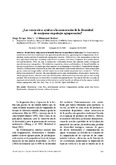| dc.description.abstract | Do live fences help conserve butterfly diversity in agricultural landscapes? In Central America, natural forests have been transformed into agriculture production areas, generating forest fragmentation, desertification, erosion and loss of biodiversity, among other concerns. Different tree cover compositions are kept on these agricultural landscapes, including scattered trees in pastures, live fences, fragments of secondary forests, and riparian forests. These can help in biodiversity conservation because they generate shelter, feeding and reproduction areas, among others. We studied the composition, richness and abundance of diurnal butterflies on two types of live fences in a landscape where pastures are predominant in Costa Rica’s Central Pacific Region.
Transects (120x5m) were observed for an hour (two days/habitat) in five multi-strata fences (with several plant species, strata and canopy width) and five simple fences (with smaller and pruned trees). A total of 2 782 butterflies were observed (75 species). The most abundant species were Anartia fatima, Eurema daria, Eurema nise,
Hermeuptychia hermes, Junonia evarete and Phoebis philea. Multi-strata fences had more species and can help maintain 56% of the total species observed in secondary and riparian forests. This type of live fence can play an important role in butterfly conservation in livestock areas, and its benefits are influenced by the manner in which
farmers manage their land. | es |


